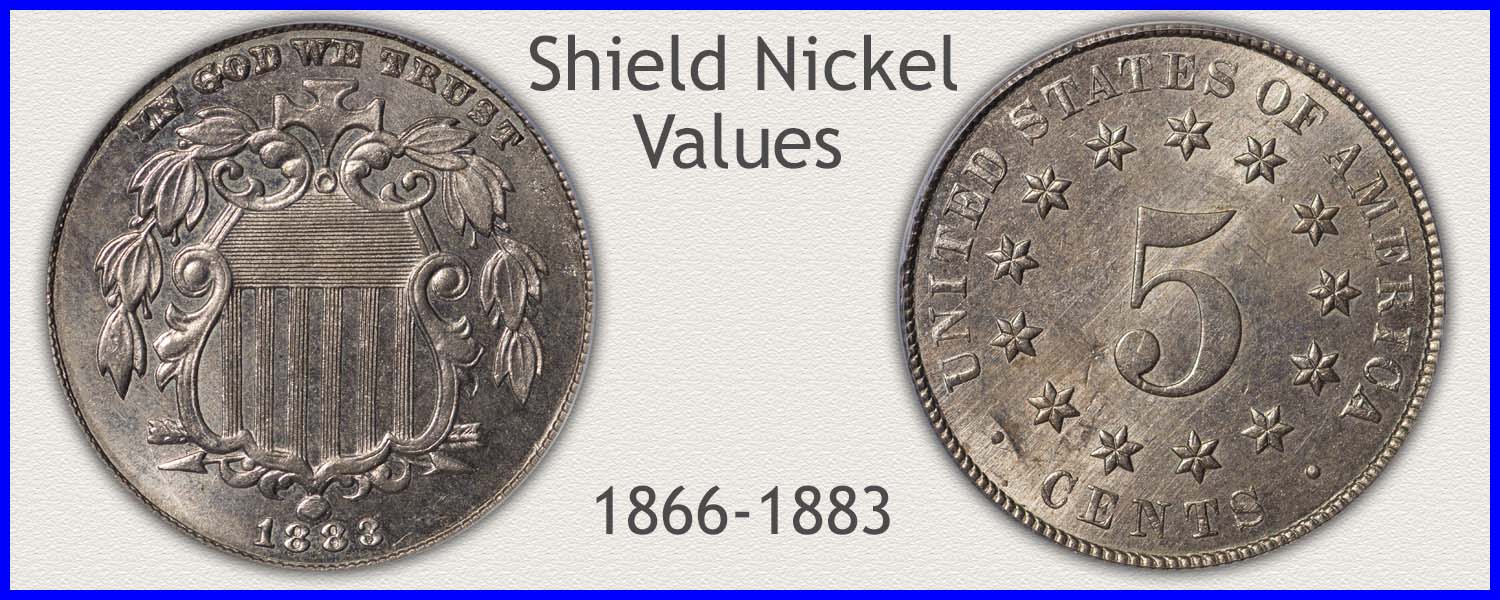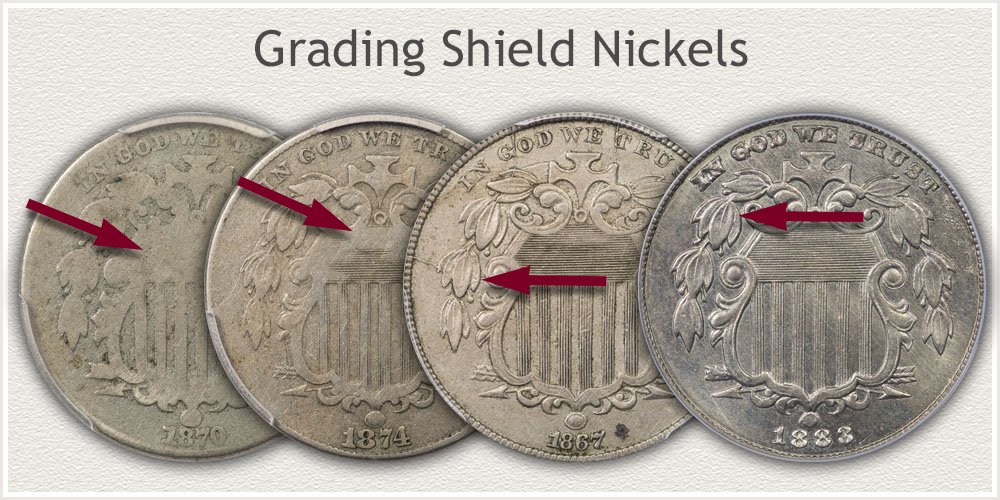Coin Values Moving with Precious Metals: Up-Dated 12/29/2025: Gold $4449 | Silver $75.46
1868 Nickel Value
A nice old nickel. A quick look at the value chart shows 1868 nickel value starts strong. The Shield nickel series, known for its basic scarcity, requires a close inspection. Higher than average quality examples are infrequent finds.
A step-by-step process identifies the key features that are important to recognize. Specifically, a coin's date and subtle condition levels. Next are qualities that appeal to the hobby and coin market. Each coin is unique in many ways. A thorough examination finds what is necessary for an accurate description.
Starting with the chart, notice the large range of how much an 1868 nickel is worth. Using the information from the examination of the coin narrows the premium range.
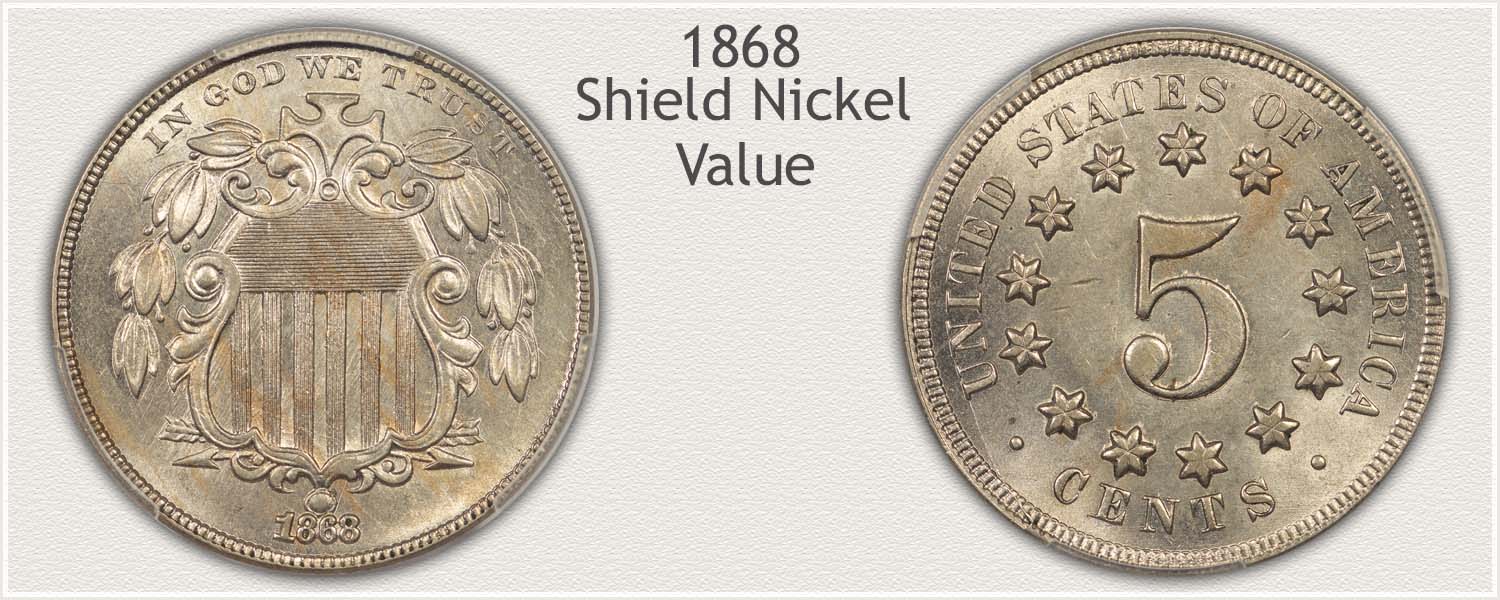
Steps Leading to Value:
- Step 1: Date Identified - A coin's date is the first sign of its potential. Confirm and record the date as part of the description.
- Step 2: Grading Condition - Visible qualities are important in the coin market. Apply grading standards to the coin to judge its condition and appeal.
- Step 3: Special Qualities - The symbolism, as part of the Shield nickel's design, assures popularity in the coin hobby.
| 1868 Nickel Value | ||||
|---|---|---|---|---|
| Condition of Coin | ||||
| Date | Good | Fine | Extremely Fine |
Mint State |
| 1868 Nickel Value Updated | 2026 | |||
| 1868 | $20 | $26 | $57 | $142 |
The above chart lists wholesale coin values. Computed from auction records, dealer's listings with various markup factors figured in. Variations in value occur subject to subtle grading points, and dealer needs.
Step 1: 1868 is a Popular Year to Many Collectors
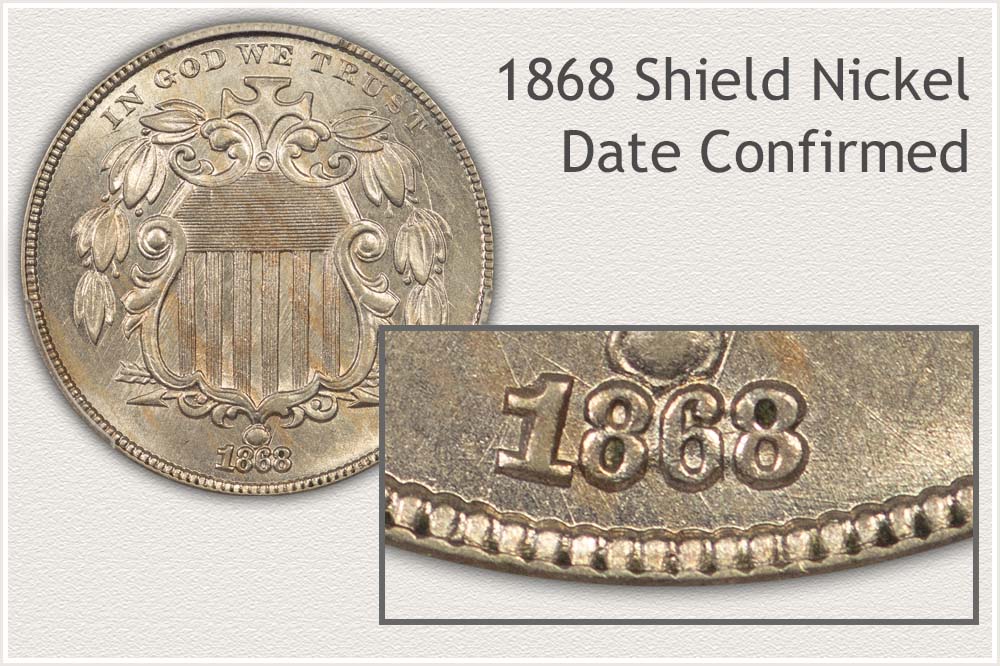
1868 Shield nickels have a positive reputation of availability. Also, this year is comparatively well struck when compared to earlier years. Often, an 1868 nickel is acquired as a nice representation of the series. Because 28.8 million were produced, many affordable examples exist. New and advanced collectors are actively building sets, creating demand for the issue.
The rarity position for this coin rates as plentiful in comparison to other dates in the series. However, all Shield nickels are scarce in relation to other nickel series. Today's collecting popularity favor later series, Liberty, Buffalo, and Jefferson nickels. 1868 is an excellent coin, to represent the early nickel alloy five cent denomination.
As part of a factual description, record an accurate date for each coin. Find the date on the obverse, the shield side, at the bottom near the rim. The size and style of the numbers are hard to read, using a magnifying glass confirms the exact date.
Step 2: | Comparing to Grade Standards Identifies Condition
Recognizing the Condition of an 1868 Nickel Finds Its Value
How well an 1868 nickel is preserved determines the next important factor in its value. Inspect the coin's condition by comparing to grading standards. When judged a specific condition, a "grade" is then assigned. These grades are then used in the coin market as part of an accurate description of the coin. Its date and grade provide a narrow range on the value chart.
When viewing the grades below, they range from no wear on the coin to heavily worn condition. With a quick comparison, find a close match with your coin. Highlighted in the image are areas to focus an examination. Grade descriptions provide details about the necessary features required at grade levels.
Mint State Grade
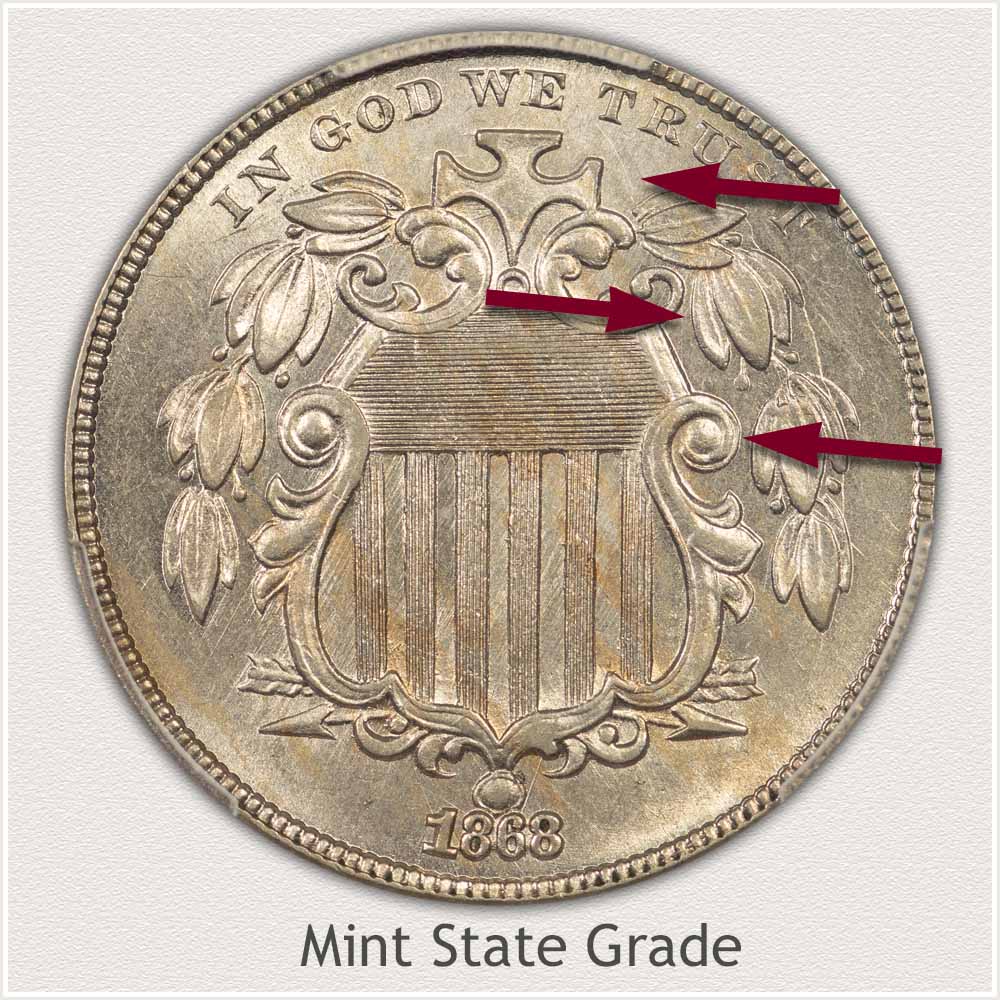
Mint State: Mint State grade 1868 nickels are a prized collectible. "Without wear" to their surface defines the condition. Mint State is the hobby term used to rate and describe the coin. These top-quality coins remain preserved in the condition they left the mint. The grading process inspects the surface to verify no trace of wear is visible.
When minting coins, the force to impress the design imparts a fine texture on the surface. This minute texture produces the shine of an unworn coin. Luster covers both low areas and importantly, high relief points of the design. Recognizing unbroken luster determines the Mint State condition.
When grading, focus on the intricate shield devices. Many high areas of the shield are prone to signs of wear. To confirm the surface is without wear, rounded elements of the frame are not flattened. On either side of the horizontal lines, two round devices are fully covered with luster. If worn, luster, and its glow, becomes a smooth surface with a metallic shine. On the right side of the shield, compare the top of the "ball" feature with the lower relief area of the leaves. Both metal surfaces are similar, with a texture of luster remaining.
Continue comparing high areas to identify a match with low relief areas. An absence of flatness or grayish tint on high points indicates a surface without wear.
Extremely Fine Grade
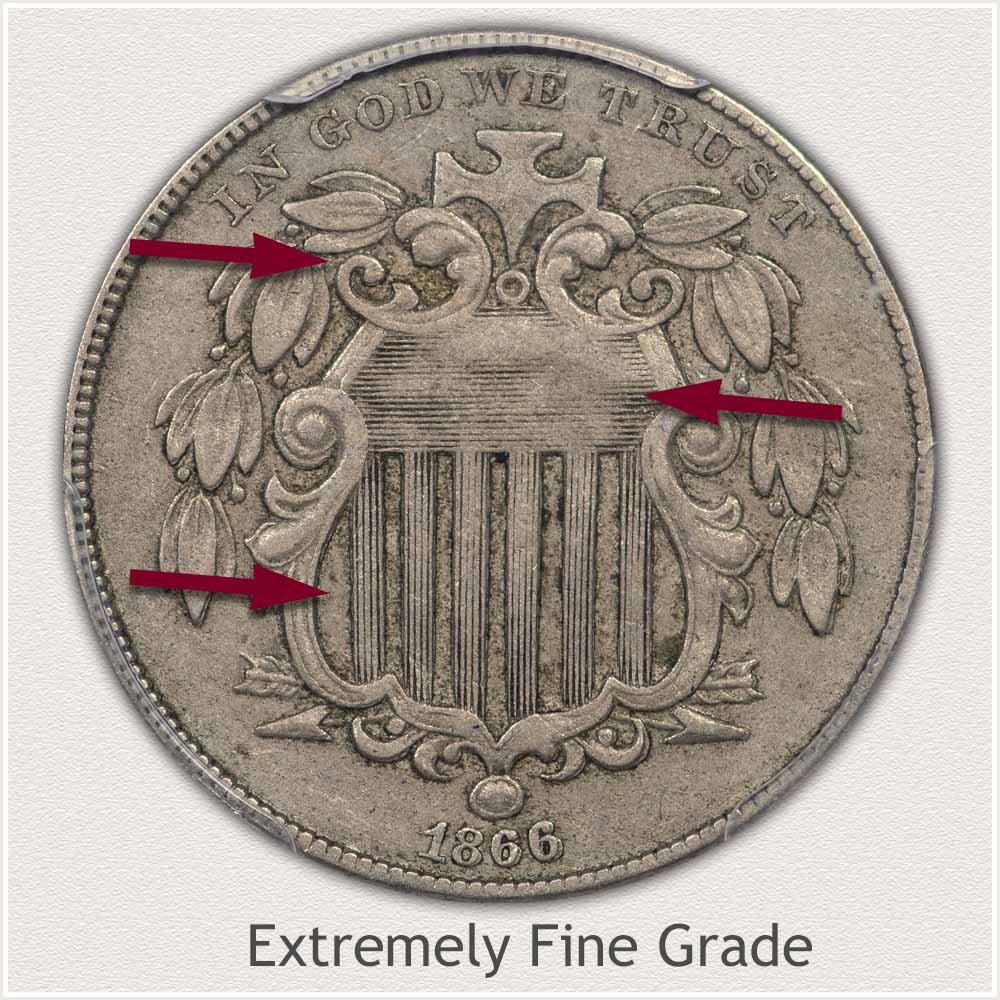
Extremely Fine: Shield nickels with just light wear defines "Extremely Fine" grade. A more complete definition includes, wear at high points only. Fine design features show only small areas of merging. Examine the image, focus on the lines in the center, and on the shield's border.
Horizontal and vertical lines in the center are useful to gauge the amount of wear. Specific standards when measured help recognize the Extremely Fine grade level. Looking at the example, both sets of lines are very clear. This provides a quick evaluation, but now it requires a close inspection and judgment.
Examine the vertical lines first. These are set within a raised bar, forming the stripes of the shield. On the top edges, slight wear reduces some lines to a faint separation. To qualify at grade level, merging of the lines is minor and short in length.
Judging the horizontal lines presents a small challenge. Strike quality is a consideration. Not all Shield nickels were strongly impressed when minted. Within the horizontal lines, softly struck areas tend to appear as wear. Light wear on these lines tends to smooth already faded areas. Typically, these soft impressed features are at the top area of the lines. If all lines, horizontal, and vertical are sharp, this easily decides the grade. If there is some fading in the horizontal lines, this requires sharp vertical lines.
With crisp and detailed lines, a Shield nickel is a candidate for the Extremely Fine grade.
Fine Grade

Fine Grade: A Shield nickel in Fine grade displays worn areas flattening the highest contours. A small amount of merging within the design features is also visible. Defining the Fine grade is low relief areas remaining with high points worn and missing.
Small details within the leaves are useful indicators of the amount of wear to the surface. Examine the edges of each leaf. Only in a few spots are leaf edges missing, if at all. The 1868 nickel image shows all edges intact, a very strong indication of the grade. Wear on the leaves only flattens the high areas, beginning at the tips. This wear on most leaves extends only half way into the leaf, a metric used when deciding the grade. Leaves worn smooth are typically the uppermost leaf of each group. Most often, this is the group either side of the cross. Missing edges in this area are acceptable for the grade.
Next, when comparing your coin to the image, confirm at least half of the horizontal lines remain. This standard considers the typical strike weakness on the top right side of the lines. Softly struck lines merge quickly when worn. Focus on the remaining lines to gauge the amount of wear.
Although worn, in Fine grade a Shield nickel is pleasing. These condition coins are well received in the market and collectible.
Good Grade
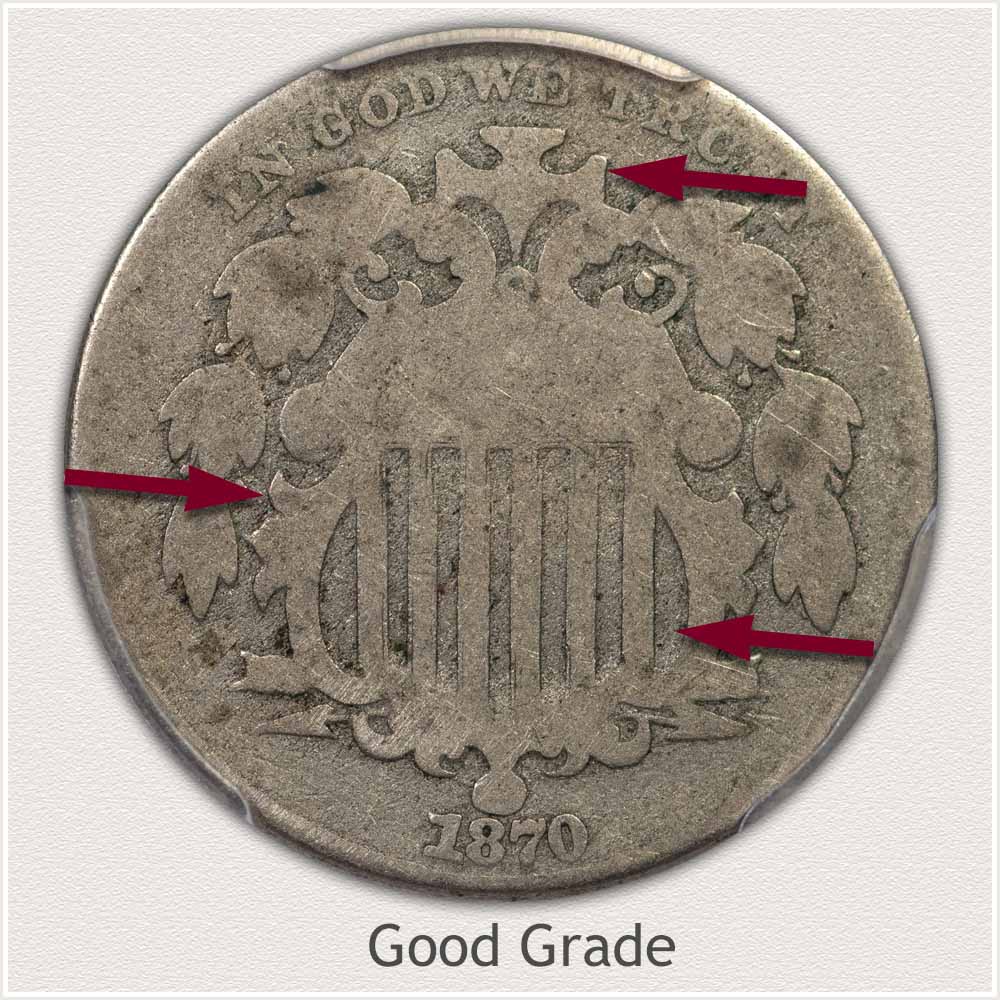
Good Grade: Viewing the example nickel, heavy wear covers the entire surface. The smooth metal hints at the missing finer detail. This look of heavy wear defines the condition. Despite the wear, key features remain and used to determine the "Good" grade.
Beginning at the center of the coin, all raised vertical lines within the shield design are full. Above these lines the area is smooth without any inner detail. This smooth area is a clear measurement of the coin's grade. Moving outward, a frame device, holding the shield is only represented by its outer edge. Without any fine details within the frame, this flatness defines heavy wear. At the very top of the central shield, a cross in outline, is bold above the background. Combined, this central area remains complete as a raised outline.
Inspect two more features, the motto and date. A full date, remains separate from the rim. A bold date is an eye appealing quality represented on this coin. Next, a strong motto above the shield also confirms the grade. Notice the motto exhibits missing detail near the rim. Remaining somewhat visible is the metric required for the motto area to meet the grade level. All combined, strong edges on main devices confirm the Good grade.
How to Video: Grading Shield Nickels
Step 3: | Special Qualities | National Symbolism
Shield Nickels and the Message They Portray
Every design element on a Shield nickel either makes a statement or symbolizes a message.
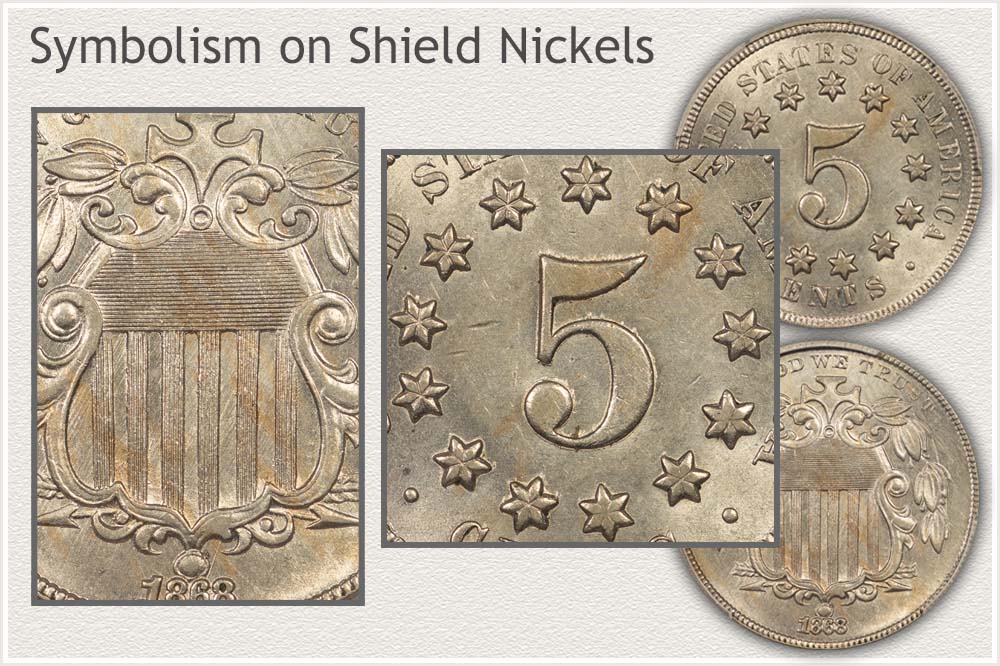 Many Messages are Portrayed by Symbolism on the Shield Nickel
Many Messages are Portrayed by Symbolism on the Shield Nickel
A few features appear on the coin as required by coinage laws. Nation of issue, UNITED STATES OF AMERICA is found on all U.S. coins. The calendar year of minting, along with the denomination. Additionally, as of 1864, the motto, IN GOD WE TRUST, appears on coinage.
The obverse of the Shield nickel satisfies the date and motto requirements. Symbolism starts within the center, its main device as a Union Shield. This is a strong symbol representing Congress and the 13 original colonies. As described in mint records, olive branches hanging from the top, garnish the shield. An olive branch is the nation's symbol of Peace. Completing the base of the shield, are two crossed arrows. These arrows represent the nation's willingness of war for its defense.
The reverse of the coin, declares the nation, UNITED STATES OF AMERICA, issued the coin. With the large 5 in the center and CENTS lower, clearly represents its domination.
Thirteen stars circle the large five. These five-pointed stars are symbolic of the 13 original colonies. Formed in a circle, they symbolize America as a nation.
The Shield nickel goes beyond its monetary function. With its motto, legend, and symbolism, each clearly representing a message. Depicted in the style of the 1860s, the design of these nickels is an important and special quality.
References
U.S. Mint. Catalogue of Coins of the United States
https://nnp.wustl.edu/library/book/554591
U.S. Mint. Symbols on Our Coins
https://www.usmint.gov/learn/history/us-circulating-coins
U.S. Mint. 1888 U.S. Mint Annual Report
https://nnp.wustl.edu/library/book/313
Coin Values | CoinStudy Articles
Date by Date
In Depth Shield Nickel Value
Shield Nickel Value | Complete Value Chart of All Years
A complete value chart lists all years, highlighting the scarce nickels. Introducing a nickel alloy five cent piece in 1866, Shield nickels are a first for U.S. coinage. Many dates in the series that ended in 1883, are scarce, if not rare.
How to Grade Shield Nickels | Visual Guide
In-depth how to grade Shield nickels. The main features of the video cover specific areas to examine. Examine closely the amount of detail required to qualify for each grade. Additionally, reference the close-up images and descriptions when inspecting a coin's surface.
Coin Value Guide | How to Value a Coin Collection
A step-by-step method combined with images works through how to value a coin collection. Sort and organize coins in a defined process. Identify each coin with accuracy, recording important details, and covering key features. Discover how much your box of old coins is worth.
Print (Printable) the Coin Values Worksheet
Organize a list of your Shield Nickels, and all coins. Filling in the columns records key features needed to determine how much they are worth. Record factual details of the date and mint varieties. Next enter their condition and special qualities. With a full description, in one place, provides a written record.
Rare Nickels of the Twentieth Century
Rare nickels, for example, ones with a slight doubling of letters, occasionally "hide" in your box of old coins. Listed are scarce dates and mintmarks and how to identify them. High quality nickels are also in favor with today's collectors. Many nickels have become rare because of age and lack of availability.
★Coin Values Discovery finds 1868 Nickel Value and...
Charts of U.S. coin values. A process of defined steps identifies features used to narrow a value range on the charts. Using images, recognize the different coin series and varieties. Completing the steps discovers how much a box of old coins is worth.
